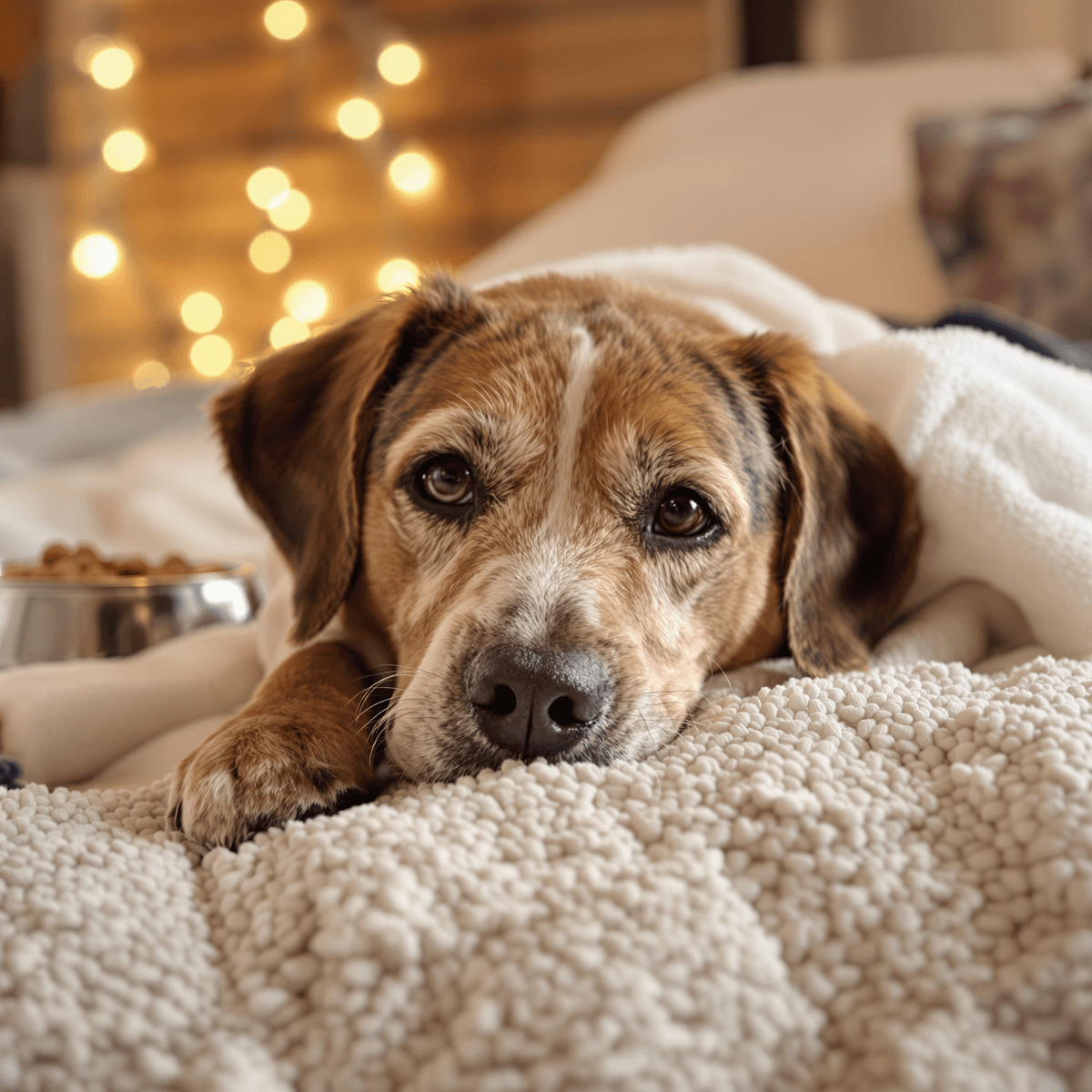- Painful cuts from sharp ice
- Frostbite in extreme conditions
- Chemical burns from road salt
- Bacterial infections
- Reduced mobility and activity levels
Expert Tip: Schedule a winter wellness check at your local vet clinic to create a personalized paw care strategy for your dog’s winter adventures. This is also a good opportunity to discuss any concerns about plant toxicity and how to keep your pet safe from these potential hazards.
Understanding Winter Risks to Dog Paws
Winter brings unique challenges to your dog’s paw health. Cold temperatures directly affect the sensitive skin of paw pads, making them dry, cracked, and prone to bleeding. The cold can also reduce blood circulation to the paws, leading to tissue damage in severe cases.Common Winter Hazards for Dog Paws:
Sharp Ice Formations
- Create cuts and abrasions on paw pads
- Risk of bacterial infections from wounds
- Can cause painful walking and limping
Snow Clumps
- Build up between toe pads
- Form hard ice balls causing discomfort
- Pull painfully on fur between toes
- Reduce traction on slippery surfaces
Moisture-Related Issues
- Prolonged exposure to wet conditions
- Increased risk of frostbite
- Softening of paw pads, making them vulnerable
- Potential development of fungal infections
Chemical Exposure Risks:
Ice-melting products pose serious threats to your dog’s paw health:- Direct chemical burns on paw pads
- Skin irritation and inflammation
- Toxic effects if licked from paws
- Disruption of natural moisture barrier
- Assessing severity of paw damage
- Providing immediate treatment for injuries
- Prescribing appropriate medications
- Monitoring healing progress
- Recommending preventive measures
- Persistent limping
- Visible cuts or cracks
- Discoloration of paw pads
- Changes in walking behavior
- Signs of pain when touching paws
Protective Measures for Winter Paw Care
Protecting your dog’s paws during winter requires a multi-faceted approach. Your local veterinary clinic can provide personalized recommendations based on your dog’s specific needs and lifestyle. The AKC has a great article on caring for Fido’s feet here. You can also read more dog paw care tips at the Web MD website here.Use of Dog Booties
Dog booties serve as the first line of defense against harsh winter conditions. These protective coverings create a reliable barrier between your pet’s sensitive paw pads and potentially harmful elements. Here’s what you need to know about selecting and using dog booties:Essential Features of Quality Dog Booties:
- Water-resistant or waterproof materials to keep paws dry
- Breathable fabric to prevent moisture buildup
- Non-slip soles for secure traction on ice
- Adjustable straps for a custom fit
- Reflective elements for visibility during dark winter walks
Getting Your Dog Used to Booties:
- Start with short indoor sessions
- Use treats and praise for positive reinforcement
- Let your dog sniff and investigate the booties before putting them on
- Put booties on one paw at a time
- Practice walking indoors before heading outside
Signs Your Dog Needs Different Booties:
- Persistent attempts to remove the booties
- Red marks or chafing around the straps
- Difficulty walking normally
- Sweating or excessive moisture inside the boots
- Signs of discomfort or stress
Professional Fitting Tips:
- Measure your dog’s paws when standing
- Allow room for natural paw spread during walking
- Check for proper ankle coverage
- Ensure straps don’t restrict blood flow
- Consider buying multiple sizes as paws may vary
Application of Paw Balm
Paw balm creates a protective barrier between your dog’s sensitive paw pads and harsh winter elements. This specialized moisturizing treatment penetrates deep into the pad tissue, preventing painful cracks and dryness while repelling snow, ice, and chemical deicers.Proper Application Technique:
- Clean and dry paws thoroughly
- Apply a thin, even layer to each pad
- Massage gently into the skin
- Let absorb for 1-2 minutes before outdoor activity
Application Timing:
- Before each winter walk
- After paw cleaning/drying
- Before bedtime for overnight healing
- Every 4-6 hours during extended outdoor activities
- Shea butter
- Coconut oil
- Beeswax
- Vitamin E
- Calendula
Signs Your Dog Needs Paw Balm:
- Rough, dry paw pads
- Minor cracks or peeling
- Redness between toes
- Excessive licking of paws
Post-Walk Paw Cleaning Practices
Cleaning your dog’s paws after winter walks isn’t optional – it’s essential for preventing chemical burns and irritation. Salt and ice-melting chemicals can linger on paw pads, causing discomfort and potential health issues if left untreated.Recommended cleaning tools from veterinary professionals:
- Microfiber towels – absorb moisture effectively without rough textures
- Pet-specific grooming wipes – contain gentle cleansers
- Silicone grooming gloves – massage while cleaning
- Paw washing cups – deep clean between pad crevices
- Gently wipe each paw with a damp cloth
- Pay special attention to spaces between paw pads
- Check for any stuck ice or snow particles
- Dry thoroughly, especially between toes
- Redness or swelling
- Cuts or abrasions
- Cracked or dry pads
- Signs of chemical burns
- Bleeding or discharge
Environmental Adjustments at Home
Creating a safe outdoor environment for your dog starts right at your doorstep. A well-maintained yard reduces the risks of winter paw injuries and chemical exposure.Essential yard maintenance practices:
- Clear designated paths through snow for your dog’s daily activities
- Remove ice buildups from walkways and common areas
- Keep snow away from fence lines where dogs frequently patrol
- Maintain a specific potty area with easy access
- Sand or kitty litter for traction
- Calcium magnesium acetate-based products
- Propylene glycol deicers
- Natural salt-free ice melters
Creating protected outdoor spaces:**
- Install temporary winter shelters near entry points
- Set up covered areas for bathroom breaks
- Place rubber mats or artificial turf patches for quick potty trips
- Build wind barriers around frequently used areas
We did a prior blog on caring for Fido’s feet, which you can read here.
Additional Winter Care Tips for Dogs’ Overall Health
Winter wellness for your dog extends beyond paw protection. Veterinarians recommend a comprehensive approach to cold-weather care that supports your pet’s entire body.Hydration Habits
- Place multiple water bowls throughout your home
- Add moisture to dry food
- Break up frozen water bowls outdoors
- Consider a pet water fountain to encourage drinking
Grooming Requirements
Regular grooming becomes crucial during winter months. Your veterinary clinic can demonstrate proper techniques for:- Trimming the fur between toe pads to prevent ice ball formation
- Maintaining appropriate nail length for better grip on slippery surfaces.
- Brushing to stimulate blood circulation and distribute natural oils
Time-Limited Winter Walks
Different dogs need different levels of cold protection: Puppies (under 1 year)- Maximum 10-15 minute walks
- Multiple short walks instead of long ones
- Watch for shivering or reluctance to move
- Brief 10-20 minute outings
- Avoid icy conditions
- Monitor joint stiffness
- Reduced exposure time
- Immediate indoor return if shivering
- Extra protection needed
Winter Wardrobe Essentials
Your dog’s winter outfit should include:- Insulated, water-resistant coat
- Adjustable straps for proper fit
- Belly coverage for maximum warmth
- Reflective elements for visibility
When to Visit a Vet or Pet Hospital for Paw Issues
Your dog’s paws need immediate veterinary attention when you notice these warning signs:Red Flag Symptoms
- Persistent limping lasting more than 24 hours
- Bleeding or deep cuts between paw pads
- Cracked or split paw pads that don’t heal
- Discoloration or darkening of the skin
- Swelling or inflammation around the paws
- Excessive licking or chewing of the paws
- Blisters or open sores
- Signs of infection including pus or unusual odor
Frostbite Indicators
- Pale or bluish-colored paw pads
- Cold and brittle skin texture
- Visible skin damage or peeling
- Pain or tenderness when touched
- Redness between paw pads
- Visible irritation or raw spots
- Reluctance to walk on treated surfaces
- Excessive drooling after licking paws
- Assess the severity of paw injuries
- Clean and treat wounds properly
- Prescribe appropriate medications
- Recommend specific protective measures
- Monitor healing progress
- Provide bandaging when needed
Conclusion
Taking care of your dog’s paws in winter can make all the difference between a painful outdoor experience and a fun snow adventure. By being proactive and using booties, balms, and regular cleaning, you can ensure that your furry friend’s feet stay healthy and strong throughout the cold season. When it comes to caring for your pet, local veterinarians are always ready to help. The dedicated teams at pet clinics in Oshawa and Bowmanville are available to provide guidance on winter-specific challenges. These veterinarians have specialized knowledge in treating cold-weather paw injuries and can recommend the most effective protective measures for your dog’s unique needs.Remember these key actions for winter paw health:
- Monitor your dog’s paws regularly for signs of damage
- Use appropriate protective gear before outdoor activities
- Clean paws thoroughly after each winter walk
- Contact your local vet at the first sign of paw issues
FAQs (Frequently Asked Questions)
Why is winter paw care important for dogs in Oshawa and Bowmanville?
Winter paw care is crucial for dogs in Oshawa and Bowmanville to protect their pads from cold, ice, sharp cuts, snow clumps, frostbite, and harmful ice-melting chemicals. Proper care helps prevent injuries and ensures your dog enjoys safe outdoor activities during the winter months.What are common winter hazards affecting dog paws?
Common winter hazards include sharp ice cuts, snow clumps between paw pads causing discomfort, frostbite risk from dampness, and exposure to toxic ice-melting chemicals. These factors can lead to pain, infections, or long-term paw damage if not addressed promptly.How do dog booties help protect paws during winter?
Dog booties act as physical barriers against ice, snow, moisture, and harmful chemicals. Quality booties should be waterproof, breathable, and nonslip to provide comfort and safety. Acclimating your dog to wear booties gradually is important, and consulting a veterinarian is advised if any discomfort occurs.What role does paw balm play in winter paw care?
Paw balm protects dog paws by moisturizing pads and shielding them from moisture and irritants like salt and chemicals. Applying balm before outings helps maintain healthy skin. Veterinarians can recommend safe and effective balms suited for your dog’s needs.How should I clean my dog’s paws after winter walks?
After walks, it’s essential to wipe your dog’s paws with towels or grooming gloves to remove salt, chemicals, and debris that can cause irritation or toxicity. Regular inspection for cuts or swelling can help detect issues early. Veterinary clinics in Oshawa and Bowmanville offer guidance on proper cleaning techniques.When should I visit a veterinarian for my dog’s paw issues during winter?
Seek veterinary care if your dog shows persistent limping, swelling, cuts that do not heal, or signs of infection. Local vet clinics and animal hospitals in Oshawa and Bowmanville are equipped to diagnose and treat paw injuries promptly to ensure your dog’s health and comfort.Contact Our Bowmanville, ON Animal Clinic To Make An Appointment
Are you searching for a vet near me in the Bowmanville, ON area? Your search is over! Please reach out to us anytime.Visit our Service page here for more insight about our clinic and the animals we treat.
This blog is meant to be informational only. Always consult with your veterinarian for the right medical advice, diagnosis, or treatment plan for your pet and follow their advice.



